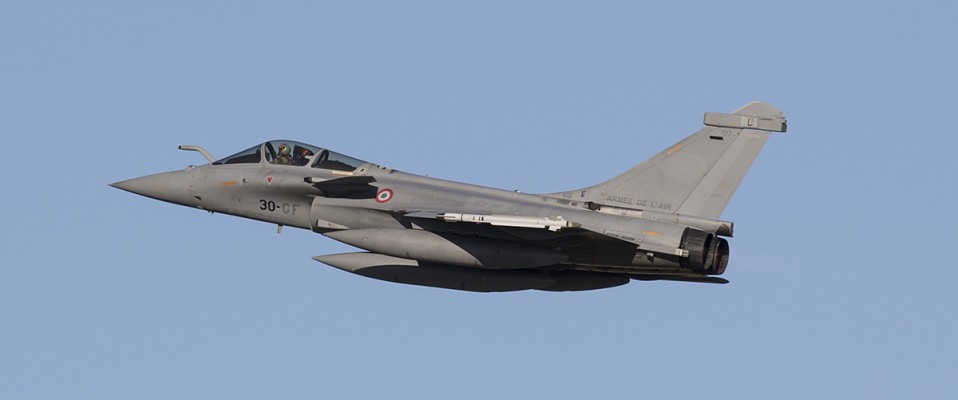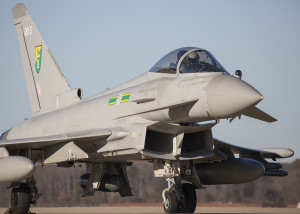TriLateralEx 2015; Air Force Leadership Reveals Preparation for Future Air Warfare
Todd Miller visited Joint Base Langley-Eustis for the inaugural Trilateral Exercise featuring air forces from the U.S., UK and France. Todd gives us an inside look at the exercise and the sophiticated aircraft that participated…
Article and photos by Todd Miller
December 23, 2015
T
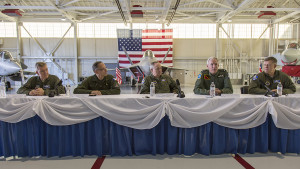
Inaugural TriLateral Exercise Press Conference, JBLE. General H. Carlisle, Commander Air Combat Command USAF; General Antoine Crux, the French Air Force Inspector General; General Mark Welsh III, Chief of Staff USAF; Sir Andrew Pulford, Chief of the RAF; General Frank Gorenc, Commander USAFE.
Colonel Broadwell, the Commander of the 1st Operations Group based at JBLE commented that the exercise was “an unprecedented opportunity. The three premier fighter aircraft of these nations had not previously trained together, and it was great to train with them, rather than just meet them in the theater (AOR).”
Contrary to popular thought, the exercise had little to do with air warfare taking place today over Syria and Iraq. Colonel Michel Friedling, Chief of the Air Force planning bureau within the French Ministry of Defense noted “Our role is to think beyond what is going on right now so we can maintain air superiority in future air operations. Our job is to imagine the way we can operate together in a contested environment, for the next decade.” Progress made since the TriLateral Initiative was announced in 2010 has the United Kingdom, France and the United States featuring regular officers not just at the exchange level as pilots, but as regular appointees in the strategic steering groups. Allied steering of strategy demonstrates a tremendous degree of trust and speaks of the closeness and importance of these relationships.
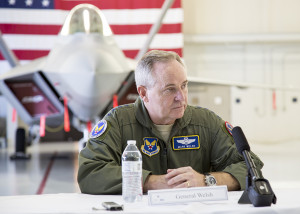
Chief of Staff of the Air Force General Mark A. Welsh III udring press conference at the inaugural TriLateral Exercise held at JBLE.
Leadership consistently made the point that the TriLateral Exercise was, in many ways, a counterpoint to that type of air warfare experienced in the past 15 to 25 years that has shown no substantial threat to allied air dominance in a theater of war. General Mark Welsh III, Chief of Staff USAF noted, “I think the big benefit of the exercise is that these three air forces have capability that many air forces don’t. This exercise places our air crews, maintenance crews, intelligence support teams in a scenario that is more demanding than the ones we have recently seen around the world. As such it prepares us for a future operating environment that may be more difficult than what we have been fighting in, and is really an important step to refocusing on that full spectrum fight that we have not been involved with in recent years but is always a potential in the future.”
In a similar vein of thought, Chief of the Air Staff (RAF), Air Chief Marshal Sir Andrew Pulford noted that, in many ways, due to the operational pace and the type of uncontested air warfare the RAF has been involved in “the higher end skills to deal with air warfare in the contested space have been reduced, and they are now working a defined program to bring baseline skills up.”
More specifically, General Frank Gorenc, Commander USAFE noted, “the exercise is focused on utilizing the capabilities of the aircraft to penetrate Anti-Access/Area Denial (A2AD) environments, places where potential adversaries have taken what are very complex, very capable surface to air missile systems putting them together in a way that they are layered. This provides a redundancy in the same air space with the express purpose of making sure that whatever area we are talking about cannot be attacked from the air.”
Some of the most effective and sophisticated systems that support A2AD are the Russian S-300 and S-400 air defense systems. These systems (and like) are proliferating around the globe at an alarming rate. While not being specific in naming the systems or potential theaters, General Mark Welsh noted that while there may be “10 integrated Air Defense systems in the world today, they anticipate that there will be 25 such systems deployed globally in 10 years.” The Air Force must be able to “dismantle them, create lanes – until then, the military cannot can’t perform effective land and sea operations.” One can certainly see the three featured aircraft and the incoming F-35 (and additional weapons systems like the EA-18 Growler) playing a critical part in “creating lanes” through an area featuring advanced A2AD.
To those ends, the 5th generation Raptor, and 4.5 generation Typhoon and Rafale took to the skies multiple times a day to refine Tactics, Techniques and Procedures (TTPs). Primary objectives included simply learning to communicate effectively, and then utilizing each platforms strengths to defeat A2AD environments. General H. Carlisle, Commander Air Combat Command USAF noted that they are “three great aircraft – together they can do so much more than they can individually because they bring strengths that complement each other and make the whole force that much better.”
To assist in the realism, F-15E Strike Eagles (Seymour Johnson AFB, NC) and T-38 Talon adversary aircraft (JLBE) flew as adversaries to the missions. The missions also featured the completely upgraded and recently deployed E-3G Block 40/45 Airborne Warning and Control Systems (AWACS) and various tanker aircraft.
One of the clear messages of the exercise was the commitment to leverage and maintain a technological edge in the future Air Force. Technology will be critical to address the full spectrum threats in a given theater; Surface to Air missile systems, Air to Air platforms, Electronic Warfare, Cyberattack and more.
General Mark Welsh noted, “For the last 15 years we’ve been focused on an environment that is very permissive and as a result the legacy systems we’ve had in our air force that made us great for the last 50 years have been very successful. We must modernize our air force so that we’re great for the next 50 years, and unfortunately there’s nothing operationally today that is driving that modernization except threats that could emerge. What’s very clear in lessons learned from this exercise is that the technical capability that we bring to the fight will continue to drive success or failure. Air forces that fall behind the technology curve will fail, and we can’t let that happen.”

French Armee De L’Air Rafale C taxis to launch during the TriLateral Exercise at JBLE.
The cost of deploying sophisticated and technologically advanced systems is high (F-22, F-35, LRS-B) and requires a careful balance to ensure adequate force size is maintained. General Mark Welsh commented to that, “we have to maintain a balance of capability, capacity and readiness. The price of systems has prohibited us from buying all top end equipment over time. Quantity does have a quality all its own in this business, especially if you are expected to respond to multiple places and we are a global Air Force. And so we are going to have to look at a high low mix of capability. But we must modernize the high end capability and then reduce cost in providing capability for the low threat spectrum. We’re going to have to do that. And we have to be allowed to divest some of the capability that made us great in order to invest in the things that will make us great. We have to be able to do that. There are some tough decisions that have to be made, or our policy makers need to decide how they want to use their instrument of national power in a different way then we have been using it.”
Air Chief Marshal Sir Andrew Pulford referenced the United Kingdom’s recent political response to the same dynamic, “my own Air Force is now smaller arguably than it’s been in its service history, but it’s also I would argue in so many ways the most potent that it’s ever been. And that balance between investment and financial challenges of investment in technology and pure numbers is one that you’ve only got to look at this recent Defense & Security Review in the UK to see what the British Government were able to do. They recognized that there was an aspect when it came to numbers and we are adding two additional Typhoon Squadrons to the mix and additional F-35 Lightning’s brought into the mix, that weren’t in the plan. They have looked at the balance between money available and threat and they have decided to invest arguably for the first time in some time in the Royal Air Force, Royal Navy and the British Army.”
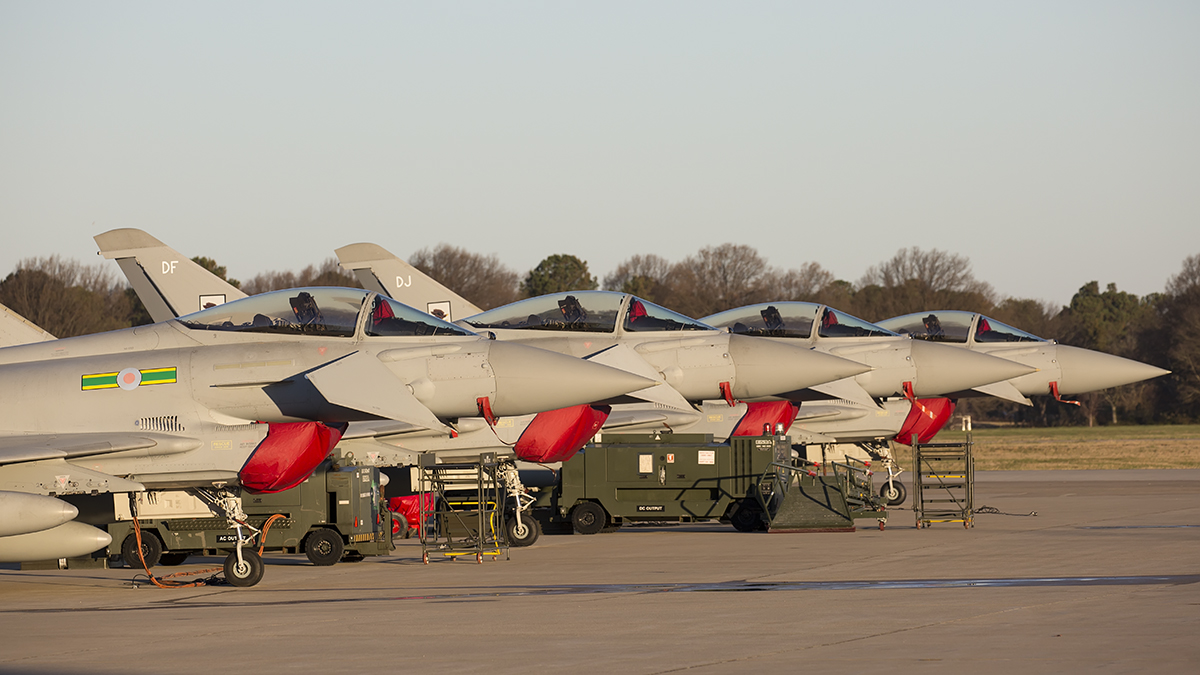
RAF 3 & 11 SQN Typhoon line in morning light at the inaugural TriLateral Exercise at JBLE.
The value of the face to face interaction among flight crew, engineers, intelligence officers and support teams during the TriLateral Exercise was recognized. Communication methods, operational practices and tactical approaches were refined between aircraft and the respective air forces. It is anticipated that there will be regular TriLateral exercises in the future, some of which will likely be held in the UK and France.
General Antoine Crux, the French Air Force Inspector General commented on the importance of the exercise, “this exercise is very important for us for we are preparing not only for war we have been fighting and have fought for years but also for the war where for example air superiority will not be granted. So we need to be sure that we will be ready to operate together very quickly on day one, as soon as our political leaders will ask.” It appears that the exercise has been very successful, and one can anticipate that when participating crews arrive in a future theater they will be much better prepared to work as one to defeat whatever threat awaits.
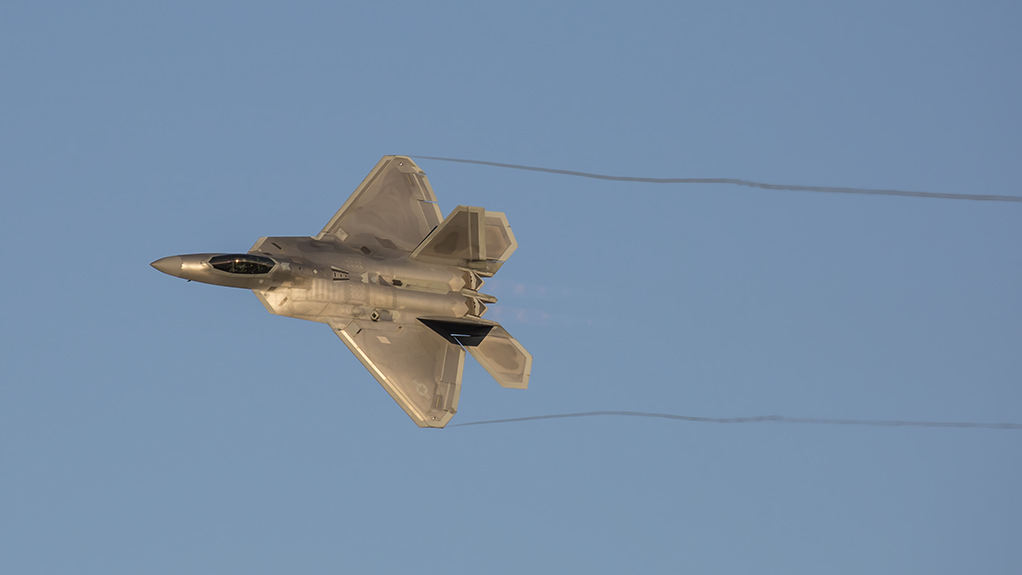
F-22A Performs demo at TriLateral Exercise Media day, Raptor marking indicates it is associated with the 192d FW, a Virgina ANG unit integrated with the 1 FW.
Todd Miller resides in rural Maryland west of Baltimore. Given less than required eyesight Todd’s dreams of fighter pilot were grounded, but the love of military aviation has never subsided. Todd enjoys capturing military aircraft through photography, with a particular desire to capture them in mission action. When not busy chasing jets, Todd works in the area of Business Development for a prominent flooring materials company.
Todd can be reached at: [email protected]


